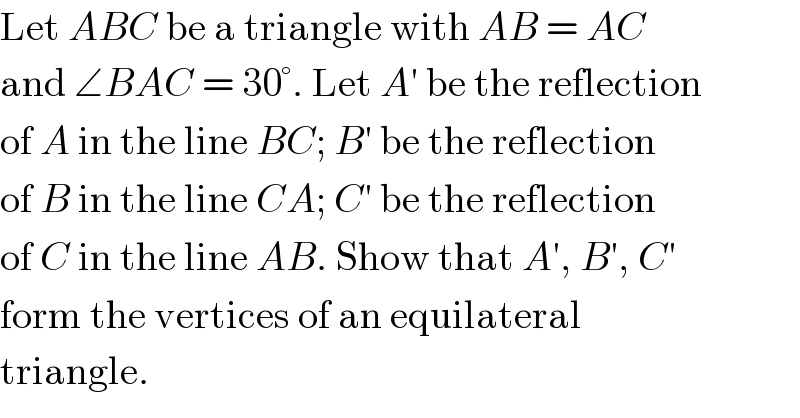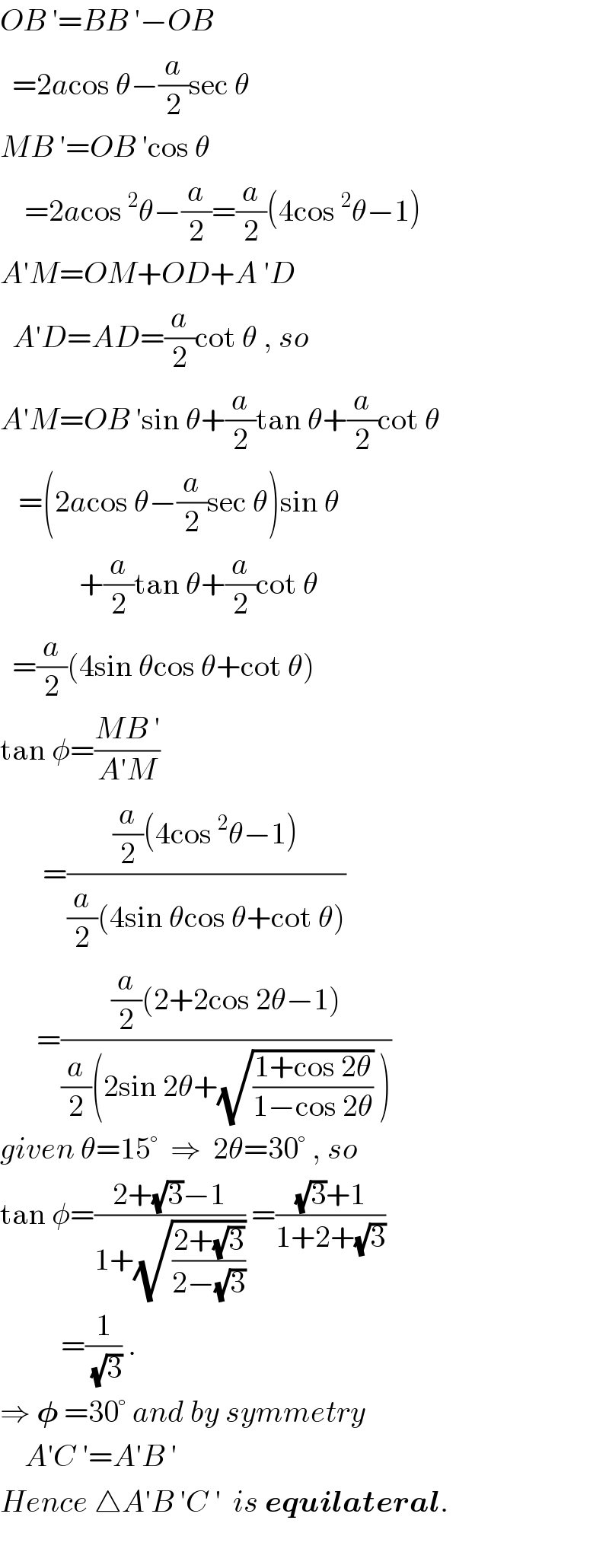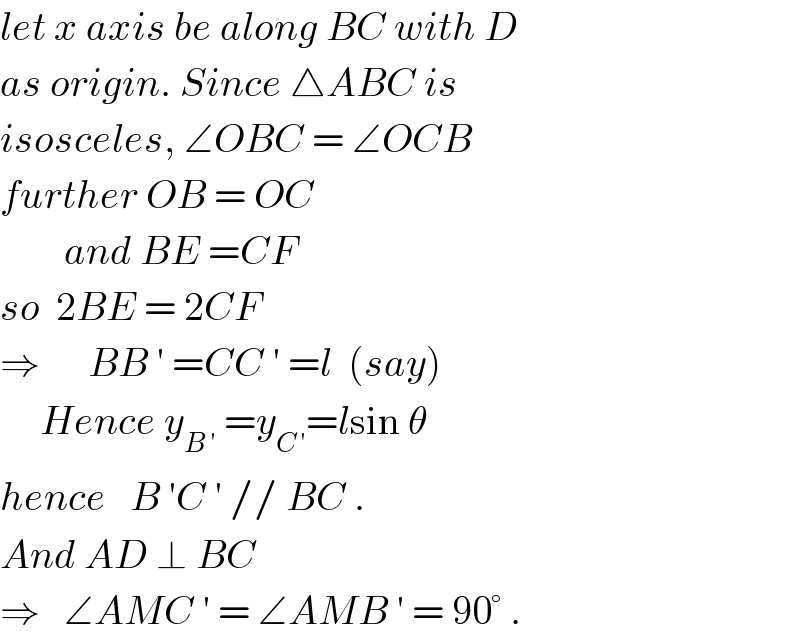
Question Number 23592 by Tinkutara last updated on 02/Nov/17

$$\mathrm{Let}\:{ABC}\:\mathrm{be}\:\mathrm{a}\:\mathrm{triangle}\:\mathrm{with}\:{AB}\:=\:{AC} \\ $$$$\mathrm{and}\:\angle{BAC}\:=\:\mathrm{30}°.\:\mathrm{Let}\:{A}'\:\mathrm{be}\:\mathrm{the}\:\mathrm{reflection} \\ $$$$\mathrm{of}\:{A}\:\mathrm{in}\:\mathrm{the}\:\mathrm{line}\:{BC};\:{B}'\:\mathrm{be}\:\mathrm{the}\:\mathrm{reflection} \\ $$$$\mathrm{of}\:{B}\:\mathrm{in}\:\mathrm{the}\:\mathrm{line}\:{CA};\:{C}'\:\mathrm{be}\:\mathrm{the}\:\mathrm{reflection} \\ $$$$\mathrm{of}\:{C}\:\mathrm{in}\:\mathrm{the}\:\mathrm{line}\:{AB}.\:\mathrm{Show}\:\mathrm{that}\:{A}',\:{B}',\:{C}' \\ $$$$\mathrm{form}\:\mathrm{the}\:\mathrm{vertices}\:\mathrm{of}\:\mathrm{an}\:\mathrm{equilateral} \\ $$$$\mathrm{triangle}. \\ $$
Answered by ajfour last updated on 02/Nov/17

Commented by Tinkutara last updated on 06/Nov/17

Commented by Tinkutara last updated on 06/Nov/17

Commented by ajfour last updated on 02/Nov/17

$${Given}\:\boldsymbol{\theta}=\mathrm{15}°\:,\:{to}\:{prove}\:\boldsymbol{\phi}=\mathrm{30}° \\ $$
Commented by ajfour last updated on 02/Nov/17

$${OB}\:'={BB}\:'−{OB} \\ $$$$\:\:=\mathrm{2}{a}\mathrm{cos}\:\theta−\frac{{a}}{\mathrm{2}}\mathrm{sec}\:\theta \\ $$$${MB}\:'={OB}\:'\mathrm{cos}\:\theta \\ $$$$\:\:\:\:=\mathrm{2}{a}\mathrm{cos}\:^{\mathrm{2}} \theta−\frac{{a}}{\mathrm{2}}=\frac{{a}}{\mathrm{2}}\left(\mathrm{4cos}\:^{\mathrm{2}} \theta−\mathrm{1}\right) \\ $$$${A}'{M}={OM}+{OD}+{A}\:'{D} \\ $$$$\:\:{A}'{D}={AD}=\frac{{a}}{\mathrm{2}}\mathrm{cot}\:\theta\:,\:{so} \\ $$$${A}'{M}={OB}\:'\mathrm{sin}\:\theta+\frac{{a}}{\mathrm{2}}\mathrm{tan}\:\theta+\frac{{a}}{\mathrm{2}}\mathrm{cot}\:\theta \\ $$$$\:\:\:=\left(\mathrm{2}{a}\mathrm{cos}\:\theta−\frac{{a}}{\mathrm{2}}\mathrm{sec}\:\theta\right)\mathrm{sin}\:\theta \\ $$$$\:\:\:\:\:\:\:\:\:\:\:\:\:+\frac{{a}}{\mathrm{2}}\mathrm{tan}\:\theta+\frac{{a}}{\mathrm{2}}\mathrm{cot}\:\theta \\ $$$$\:\:=\frac{{a}}{\mathrm{2}}\left(\mathrm{4sin}\:\theta\mathrm{cos}\:\theta+\mathrm{cot}\:\theta\right) \\ $$$$\mathrm{tan}\:\phi=\frac{{MB}\:'}{{A}'{M}} \\ $$$$\:\:\:\:\:\:\:=\frac{\frac{{a}}{\mathrm{2}}\left(\mathrm{4cos}\:^{\mathrm{2}} \theta−\mathrm{1}\right)}{\frac{{a}}{\mathrm{2}}\left(\mathrm{4sin}\:\theta\mathrm{cos}\:\theta+\mathrm{cot}\:\theta\right)} \\ $$$$\:\:\:\:\:\:=\frac{\frac{{a}}{\mathrm{2}}\left(\mathrm{2}+\mathrm{2cos}\:\mathrm{2}\theta−\mathrm{1}\right)}{\frac{{a}}{\mathrm{2}}\left(\mathrm{2sin}\:\mathrm{2}\theta+\sqrt{\frac{\mathrm{1}+\mathrm{cos}\:\mathrm{2}\theta}{\mathrm{1}−\mathrm{cos}\:\mathrm{2}\theta}}\:\right)} \\ $$$${given}\:\theta=\mathrm{15}°\:\:\Rightarrow\:\:\mathrm{2}\theta=\mathrm{30}°\:,\:{so} \\ $$$$\mathrm{tan}\:\phi=\frac{\mathrm{2}+\sqrt{\mathrm{3}}−\mathrm{1}}{\mathrm{1}+\sqrt{\frac{\mathrm{2}+\sqrt{\mathrm{3}}}{\mathrm{2}−\sqrt{\mathrm{3}}}}}\:=\frac{\sqrt{\mathrm{3}}+\mathrm{1}}{\mathrm{1}+\mathrm{2}+\sqrt{\mathrm{3}}} \\ $$$$\:\:\:\:\:\:\:\:\:\:=\frac{\mathrm{1}}{\sqrt{\mathrm{3}}}\:. \\ $$$$\Rightarrow\:\boldsymbol{\phi}\:=\mathrm{30}°\:{and}\:{by}\:{symmetry} \\ $$$$\:\:\:\:{A}'{C}\:'={A}'{B}\:' \\ $$$${Hence}\:\bigtriangleup{A}'{B}\:'{C}\:'\:\:{is}\:\boldsymbol{{equilateral}}. \\ $$$$\:\:\: \\ $$
Commented by Tinkutara last updated on 02/Nov/17

$${Why}\:{AA}'\:{bisects}\:\angle{C}'{A}'{B}'? \\ $$
Commented by ajfour last updated on 02/Nov/17

$${honestly},\:{i}\:{dont}\:{know}. \\ $$
Commented by Tinkutara last updated on 06/Nov/17

Commented by ajfour last updated on 06/Nov/17

$${using}\:{which}\:\:{app}.\:{have}\:{you}\:{typed} \\ $$$${and}\:{drawn}\:{all}\:{these}\:?\: \\ $$
Commented by Tinkutara last updated on 15/Nov/17

$${Sir},\:{can}\:{you}\:{show}\:{that}\:{BC}\parallel{B}'{C}'? \\ $$$${Because}\:{I}\:{want}\:{to}\:{know}\:{how}\:{you} \\ $$$${assumed}\:\angle{AMC}'=\mathrm{90}°. \\ $$
Commented by ajfour last updated on 15/Nov/17

$${let}\:{x}\:{axis}\:{be}\:{along}\:{BC}\:{with}\:{D} \\ $$$${as}\:{origin}.\:{Since}\:\bigtriangleup{ABC}\:{is} \\ $$$${isosceles},\:\angle{OBC}\:=\:\angle{OCB} \\ $$$${further}\:{OB}\:=\:{OC} \\ $$$$\:\:\:\:\:\:\:\:{and}\:{BE}\:={CF} \\ $$$${so}\:\:\mathrm{2}{BE}\:=\:\mathrm{2}{CF} \\ $$$$\Rightarrow\:\:\:\:\:\:{BB}\:'\:={CC}\:'\:={l}\:\:\left({say}\right) \\ $$$$\:\:\:\:\:{Hence}\:{y}_{{B}\:'} \:={y}_{{C}\:'} ={l}\mathrm{sin}\:\theta \\ $$$${hence}\:\:\:{B}\:'{C}\:'\://\:{BC}\:. \\ $$$${And}\:{AD}\:\bot\:{BC}\: \\ $$$$\Rightarrow\:\:\:\angle{AMC}\:'\:=\:\angle{AMB}\:'\:=\:\mathrm{90}°\:. \\ $$
Commented by Tinkutara last updated on 15/Nov/17

$${What}\:{is}\:{y}_{{B}'} ? \\ $$
Commented by ajfour last updated on 15/Nov/17

$${I}\:{said},\:{lets}\:{take}\:{BC}\:{as}\:{x}\:{axis} \\ $$$${with}\:{D}\:{as}\:{origin}. \\ $$$${y}_{{B}\:'} \:{is}\:{y}\:{coordinate}\:{of}\:{B}\:'\:{then}. \\ $$
Commented by Tinkutara last updated on 15/Nov/17

$$\mathrm{Thank}\:\mathrm{you}\:\mathrm{very}\:\mathrm{much}\:\mathrm{Sir}! \\ $$
